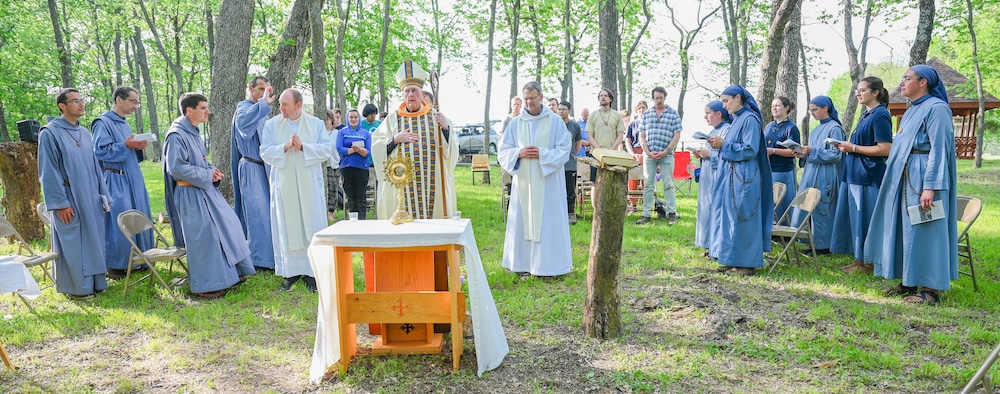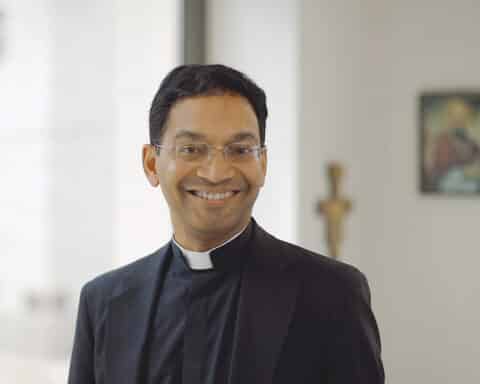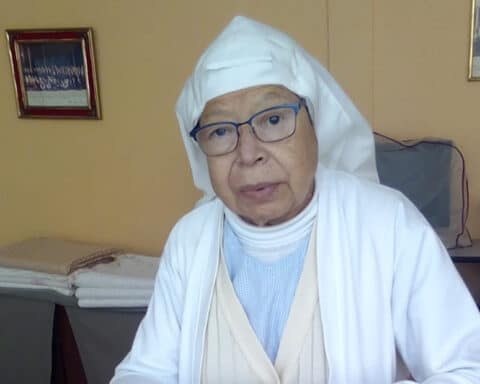Little Brothers and Little Sisters of the Lamb from around the world are gathering together in their motherhouse in France from now until May as they face a historic milestone.
The young religious institute, the Community of the Lamb, is electing the successor of its still-living founder, Little Sister Marie (religious members of the community don’t use their last names).
The community of religious sisters and brothers has made a big impact on those they have encountered for different reasons.
It’s their “epic” spirituality lived out in small wooden dwellings that interests Oscar Shingledecker, a North Carolina college student. Their distinctive sung Masses, blending the liturgies of East and West, won over Cathe Sienkiewicz, a Kansas mother and catechist. And their radically Christ-centered missionary vision attracted Aaron Riches, a theologian who has known them in two countries.
The community currently has “little monasteries” in France, Spain, Italy, Germany, Austria, Poland, Argentina, Chile, and Kansas, and are known for their mendicant lifestyle and their joyful demeanor, including putting on original plays and bursting into song.
Little Sister Marie-Jeanne, 36, from Paris, France, leads the sisters in Kansas City, Kansas. She told Our Sunday Visitor, “As Little Sisters of the Lamb, we have the great joy of being beggars. We go door-to-door, two-by-two, following in the footsteps of the disciples and of our fathers, St. Dominic and St. Francis, to ask for something to eat.”
As for the smiles and songs, she said, “We experience a joy in our need for God, because in our poverty before him, we are met with his generosity.”
The community was formed in Paris in 1968 by Dominican sisters who started to explore together the Church’s response to key questions such as “Who is God?” and “What makes us human?” In 1981, Chartres Bishop Michel Kuehn officially recognized its foundation. In 1983, Perpignan Archbishop Jean Chabbert welcomed the community to his archdiocese. Dominican Master Vincent de Couesnogle recognized the order as “a new branch emerging from the trunk of the Order of Preachers.” Since 1996, Vienna Cardinal Christoph Schönborn has been the bishop responsible for the community.
Kansas City, Kansas Archbishop Joseph Naumann welcomed them to Kansas in 2008.
“From my first encounter with the Little Sisters many years ago in Rome, I was drawn to their charism of being mendicants, beggars, depending on God’s providence for everything,” he said.
“Whenever I visit the Little Monastery, I always ask the Little Brothers and Sisters about their most recent missions,” Archbishop Naumann added. “They encounter many who are looking for a sign that God is with them: a young woman who has been sober for many years but is being tempted to drink again that day; parents who have recently experienced the death of a child; an elderly person who is lonely and feels forgotten.
They always invite those who have welcomed them to come, visit and pray at the monasteries. They conclude with singing a blessing for those who have opened their homes and hearts to them.”
An ‘Epic’ Way of Life
Oscar Shingledecker, a sophomore at Benedictine College in nearby Atchison, Kansas, met the community during his freshman year and attended their Triduum celebration, which involves an all-night vigil and a giant bonfire.
Little Brother Joachim told him, “If you ever go to France, you should visit our monastery.” So he did. With three friends in Europe for a semester abroad program, Shingledecker visited the community twice in France — at their Lyons monastery and Saint-Pierre motherhouse, 10 miles from Fanjeaux, where St. Dominic once lived.

“Their motherhouse is amazing,” said Shingledecker. “It has several structures scattered throughout the southern hills of France and many spots to pray. They had animals, too. It was beautiful.”
The Community’s monasteries are known for their distinctive wooden architecture. The small dwellings and common buildings are often compared to Hobbiton in “The Lord of the Rings.”
He said the community’s charism is “the solution” the Church needs today.
“They offer a lifestyle that models how people can maintain an interior life amidst a constantly changing schedule,” he said. “Unlike other orders, their life is not strict and regimented. They are still devoted to prayer, devoted to Christ, but in the midst of doing many different kinds of things with no set schedule. We visited a homeless man in Lyons and we cut up pigs for dinner in San Pierre.”
He added, “Their spirituality is an epic fusion of Dominican and Franciscan spirituality, which is just so cool.”
The Community has a special devotion not just to St. Dominic and St. Francis but also to St. Catherine of Siena, St. Benedicta of the Cross (Edith Stein) and St. Thérèse of Lisieux.
A Uniquely Beautiful Liturgy
Many people come to the Community of the Lamb for their distinctive liturgy.
During their founding, the community was looking for a liturgical expression that answered what the Second Vatican Council sought. “The liturgy of the Council allowed us to live at the rhythm of the heart of God and of his love for all mankind,” says the institute’s online history. The Community’s Mass is celebrated with elements of Eastern and Western traditions.
Cathe Sienkiewicz said it is both the liturgy itself and the presence of the sisters that make it special.
“The beauty comes from the deep and authentic joy of these consecrated men and women,” she said. “This joy is both exuberant and serious, and these qualities are expressed in their liturgy, which is almost entirely sung in wonderful polyphony.”
It is an oasis of peace, she said.
“I think that what people are often seeking, and not often finding, is a liturgy that is intentional, is organically connected to the community, and engages the whole person. All of these come together at the Little Brothers and Sisters,” Sienkiewicz said.
“People find themselves drawn to it, as an experience that meets a profound need,” she said.
Christ-Centered Missionaries
Above all, though, the Community of the Lamb has a mission to share the Gospel through personal witness, service, and even by performing plays.
Theologian Dr. Aaron Riches at Benedictine College first met the Little Sisters of the Lamb at their Light of Peace monastery in Granada, Spain.
“On many Saturdays when we lived in Granada we went with our kids to the monastery for open table,” he said. “When we told Hermanita [Little Sister] Fatima that we would be leaving Granada to move to Kansas she told us — with a great smile of joy — that in the providence of God we were going precisely to the one place in North America where the Community of the Lamb has a presence.”

However, “There are no Little Brothers of the Lamb in Granada,” he said. He was grateful to introduce his son to them at their “little monastery” in Kansas.
“The most moving thing I have done with the community was this winter, my son and I went on a mission overnight with two of the little brothers,” he said. “We stayed over in a homeless shelter. We lined up with everyone else. We didn’t materially help anyone. For 12 hours we were poor with the poor. They were moved by our presence; we were moved even more by their welcome.”
The community’s motto, depicted with an image of the Lamb of Revelation, is “Wounded, I never cease to love.” The repetition of the word “little” in the community’s terminology–never capitalized in their usage–is intentional: The members want to put Christ, not themselves, front and center.
Riches described the “littleness” of the Little Brothers and Little Sisters.
“Little Sister Marie-Jeanne spoke in my class and she said something along the lines that everyone has a Bethlehem in their heart into which Jesus is begging to enter. That Bethlehem, prepared for him, is not the place of our competence or virtue,” he said, but “the corner we dare not show the world.” It’s there that Jesus “desires most to come into our life as a the gentle, loving peace our healing.”
In the Heart of America
Archbishop Naumann said the archdiocese is blessed by this powerful witness, but when the Little Sisters accepted his invitation, people asked them “Why Kansas?”
“The real reason the Community of the Lamb came to Kansas is because they prayed for the Lord to send them where they were most needed,” he said. “The Holy Spirit did not guide them to Washington, D.C., our nation’s capital; nor to New York City, our country’s economic center; nor to Los Angeles, a cultural hub — but rather to the heart of our nation.”

The community is glad they did.
“What I have discovered in the United States is the generosity sown in the heart of Americans,” said Little Sister Marie-Jeanne. “It is a gift for me to witness the spontaneity and simplicity in which Americans give of themselves and their friendship.”





